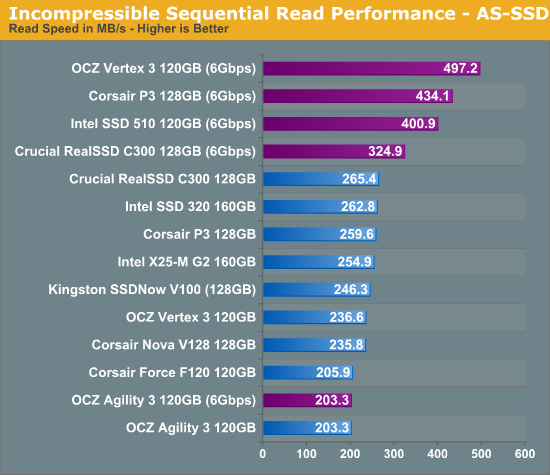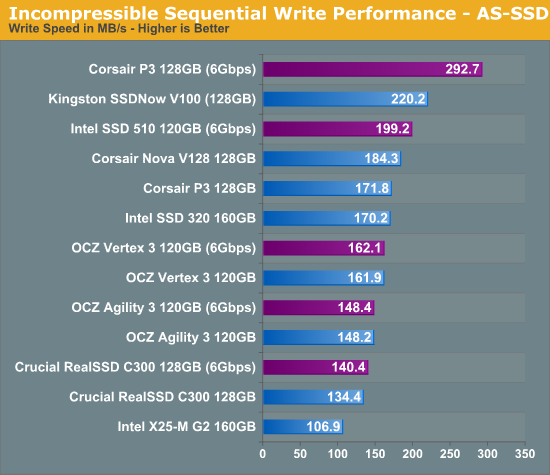The 2011 Mid-Range SSD Roundup: 120GB Agility 3, Intel 510 and More Compared
by Anand Lal Shimpi on June 7, 2011 12:52 PM ESTAS-SSD Incompressible Sequential Performance
The AS-SSD sequential benchmark uses incompressible data for all of its transfers. The result is a pretty big reduction in sequential write speed on SandForce based controllers.

Peak read speed is obviously something the Vertex 3 does very well, while the P3 and 510 fall in second and third places, OCZ has a substantial lead. Now look at what happens when AS-SSD runs a pass of incompressible writes:

Corsair's P3 is now our leader. What's important to notice here is that Corsair's firmware allows for much higher sequential performance than what Intel outfitted the 510 with, however Intel's drive generally delivers better real world performance as we've seen from our 2011 Storage Bench tests.










68 Comments
View All Comments
GrizzledYoungMan - Tuesday, June 7, 2011 - link
Just found this: http://www.overclock.net/ssd/956371-whats-best-sat...Basically answers my question right there, haha.
howelk - Wednesday, June 8, 2011 - link
I'm pondering purchase of Crucial m4-256, Intel 510, Samsung 470, or Intel 320 300GB.. system is 790GX/Phenom II 965. I'm interested in mostly hosting a bunch of VM's for home lab.kuzzia - Wednesday, June 8, 2011 - link
Thank you, thank you for also reviewing mainstream SSD's instead of the usual 240 GB. After all, not many people can afford those after all. But wonder why Intel chose to include the 160 GB instead of the 120 GB. Too afraid to show weaknesses of 120 GB?Dribble - Wednesday, June 8, 2011 - link
The 128GB version of that is probably the most popular new drive out there right now being as it's fast but significantly cheaper then the vertex 3 and the Intel 510.KenPC - Wednesday, June 8, 2011 - link
Anand,In previous articles you have very clearly shown that a sandforce sata II drive can write at no more than about 85MB/s. A sandforce sata III drive was about 135 to 150Mb;/s as I recollect.
Any reported value above these numbers is due to compression and caching within the drive controller.
This limitation becomes most clear when truly incompressible files, such as video clips, are used.
First, I question any write speed above these values that claim to be with 'incompressible' data. Even you raised a flag about this in previous articles. Read speeds may also be affected in somewhat the same way.
Sandforce controllers are clever, but you mileage may vary widely. Most benchmark tests are highly affected by the drive controller compression and caching.
Second, if compression and caching are a good thing, why not use the OS to compress and cache? In this case, the SATA bus could no longer be a bottle neck, and speeds that far exceed the SATA II or III specs are available. In this way, everyone can have the effects of a sandforce controller, except perhaps better.
For those interested in trying with a SSD drive, check 'compress this drive to save space' in W7. Then rerun the atto benchmark. I found overwhelming improvement in data transfer rates that far exceeded the sata II/III bus capability.
krazyderek - Wednesday, June 8, 2011 - link
would have loved to see a nice summary of how all the drives perform after being "abused" and trimmed, i remember that some of these drives don't handle it so well..... the c300? really would have liked to see that part of the overall comparison, especially since i'm guessing degraded performance happens to the smaller drives easier.geok1ng - Wednesday, June 8, 2011 - link
I believe that the Intel 320 series still packs a punch, given the cheaper price tag and hardware features absent from the 510 like data encription or absent from all the other consumer SSDs, like an array of caps to prevent data loss from poqer failures. Tha is an aspect of the 320 series that the round up has failed to point out.Between Intel 320 and 510 series the user trades performance for price and reliability. And Intel strategy today is to explaim to people that while there is a huge real world gap between HDD and the slowest SSD of this generation, te real worlds benefits of choosing the fastest SSD today and the slowest are dim to non-existant.
Bigu - Wednesday, June 8, 2011 - link
It's interesting to see that between Intel 510 250GB and 120GB, the smaller drive performs much better in random writes. (from this chart http://www.anandtech.com/show/4244/intel-ssd-320-r...In fact, generally, the gap between these two are smaller than that between 320 300GB and 160GB, as well as OCZ V3 240GB and 120GB.
Fallen Kell - Wednesday, June 8, 2011 - link
This is exactly the kind of comparison I had been looking for, and timing couldn't have been more perfect (I only started looking for this comparison 4 hours AFTER you had posted it). It made my decision pretty easy. I went with the Intel SSD 510 120GB. With the issues that are occurring on all the Sandforce 2200-2500 controllers, I ruled them out (Corsair just recalled all of their drives.... I suspect that others will have to do the same). And the performance really isn't that much worse in general. While I considered the C300, the very small reserved area is what lead me to remove it from my list. So that only left the 2 Intel drives, and given the fact that the 510 performed better and was cheaper (with less disk space), it was the right choice for me.ArtShapiro - Wednesday, June 8, 2011 - link
I too want to extend my appreciation for an informative and understandable article!Am I the only one who has been afraid to jump into the SSD camp due to concerns about reliability? I'm backed up by Windows Home Server daily on all my machines, but the thought of getting bricked is still unpleasant. Yeah, magnetic drives eventually fail, but not very often.
I wonder if this new Z68 caching facility offers the optimal solution - pretty darned fast, a nice improvement over a straight magnetic system, and (I assume) no grievous hardship if the SSD starts pining for the fjords.
Art